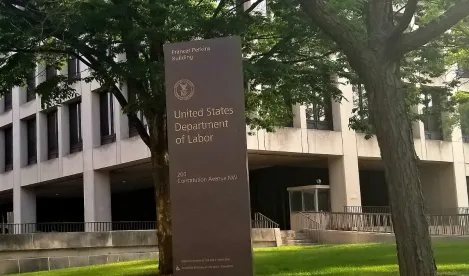As part of the first “comprehensive regulatory review” in nearly 40 years, the Department of Labor (DOL) recently proposed to amend, update, and “modernize” the regulations at 29 CFR parts 1, 3, and 5, which implement the Davis-Bacon Act (DBA) and the Davis-Bacon Related Acts (collectively, the DBRA). The background on and an overview of these important revisions to the DOL’s regulations, which set forth rules for the administration and enforcement of the Davis-Bacon labor standards that apply to federal and federally assisted construction projects, are discussed below.
Background
-
The DBA, enacted in 1931, requires the payment of locally prevailing wages and fringe benefits on federal contracts for construction (see 40 U.S.C. § 3142). The DBA applies to workers on contracts with federal agencies and the District of Columbia that are in excess of $2,000 for the construction, alteration, or repair of public buildings or public works. Congress subsequently incorporated DBA prevailing wage requirements into numerous statutes (referred to by the DOL as “Related Acts”) under which federal agencies assist construction projects through grants, loans, loan guarantees, insurance, and other methods.
-
Congress has delegated authority to the DOL to issue prevailing wage determinations and prescribe rules and regulations for contractors and subcontractors on DBA-covered construction projects (see 40 U.S.C. §§ 3142, 3145). Congress has also directed the DOL to “prescribe appropriate standards, regulations and procedures” to be observed by federal agencies responsible for the administration of the DBA and Related Acts (5 U.S.C. app. 1, effective May 24, 1950, 15 FR 3176, 64 Stat. 1267). These regulations, which have been updated and revised periodically over time, are primarily located in parts 1, 3, and 5 of title 29 of the Code of Federal Regulations.
-
The DOL last engaged in a comprehensive revision of the regulations governing the DBA and the Related Acts in 1981-1982. Since that time, Congress has expanded the reach of the Davis-Bacon labor standards, adding numerous new Related Act statutes to which these regulations apply. The DBA “and now 71 active Related Acts 4 collectively apply to an estimated $217 billion in Federal and federally assisted construction spending per year and provide minimum wage rates for an estimated 1.2 million U.S. construction workers.” The DOL reports that it expects these numbers to continue to grow as federal and state governments seek to address the significant infrastructure needs of the country, including “the energy and transportation infrastructure necessary to mitigate climate change.”
-
In addition to the expansion of the prevailing wage rate requirements of the DBA and the Related Acts, the DOL notes that “the Federal contracting system itself has undergone significant changes since the 1981-1982 rulemaking.” Federal agencies have dramatically increased spending through interagency federal schedules such as the Multiple Award Schedule (MAS). Contractors have increased their use of single-purpose entities, such as joint ventures and teaming agreements, in construction contracts with federal, state, and local governments. Federal procurement regulations have been overhauled and consolidated in the Federal Acquisition Regulation (FAR), which contains a subsection on the Davis-Bacon Act and related contract clauses (see 48 CFR § 22.400 et seq.). Further, court and agency administrative decisions have developed and clarified myriad aspects of the laws governing federal procurement.
-
During the past 40 years, the DOL’s DBRA program also has continued to evolve. Where the program initially was focused on individual project-specific wage determinations, contracting agencies now incorporate the DOL’s general wage determinations for the construction type in the locality in which the construction project is to occur. The program also “now uniformly uses wage surveys to develop general wage determinations, eliminating an earlier practice of developing wage determinations based solely on other evidence about the general level of unionization in the targeted area.” In a 2006 decision, the DOL’s Administrative Review Board (ARB) identified several survey-related wage determination procedures then in effect as inconsistent with the regulatory language that had resulted from the 1981-1982 rulemaking (see Mistick Constr., ARB No. 04-051, 2006 WL 861357, at *5-7 (Mar. 31, 2006)). Because of these developments, “the use of averages of wage rates from survey responses has increasingly become the methodology used to issue new wage determinations — notwithstanding the department’s long-held interpretation that the DBA allows the use of such averages only as a methodology of last resort.”
-
The DOL also has “received significant feedback from stakeholders and others since the last comprehensive rulemaking.” In a 2011 report, the Government Accountability Office (GAO) reviewed the DOL’s wage survey and wage determination process and found that the DOL was often behind schedule in completing wage surveys, leading to a backlog of wage determinations and the use of out-of-date wage determinations in some areas. The GAO report also identified dissatisfaction among regulated parties regarding the rigidity of the DOL’s county-based system for identifying prevailing rates, and missing wage rates requiring an overuse of “conformances” for wage rates for specific job classifications. A 2019 report from the DOL’s Office of the Inspector General (OIG) made similar findings regarding out-of-date wage determinations.
-
DOL notes that it has also encountered significant enforcement challenges. Among the most critical of these, according to DOL, is the omission of DBRA contract clauses from contracts that are clearly covered by the DBRA.
-
Accordingly, the DOL “now seeks to address a number of these outstanding challenges in the program while also providing greater clarity in the DBRA regulations and enhancing their usefulness in the modern economy.”
Overview of Proposed Amendments
-
The DOL proposes to update and modernize the regulations implementing the DBRA at 29 CFR parts 1, 3, and 5. In some of these revisions, the DOL has determined that changes it made in the 1981-1982 rulemaking were mistaken or ultimately resulted in outcomes that are increasingly in tension with the DBA statute itself. In others, the DOL seeks to expand further on procedures that were introduced in that last major revision, or to propose new procedures that will increase efficiency of administration of the DBRA and “enhance protections for covered construction workers.”
-
The proposed rule includes several elements targeted at increasing the amount of information available for wage determinations and speeding up the determination process. In a proposal to amend § 1.3 of the regulations, the DOL outlines a new methodology to give the Wage and Hour Division (WHD) administrator authority and discretion to adopt state or local wage determinations as the Davis-Bacon prevailing wage where certain specified criteria are satisfied. Such a change “would help improve the currentness and accuracy of wage determinations, as many states and localities conduct Department and have relationships with stakeholders that may facilitate the process and foster more widespread participation.” This proposal also aims to “increase efficiency and reduce confusion for the regulated community where projects are covered by both DBRA and local or State prevailing wage laws and contractors are already familiar with complying with the local or State prevailing wage requirement.”
-
The DOL also proposes changes to the definition of “prevailing wage” in § 1.2 and to the scope of data in § 1.7 to be considered to identify the prevailing wage in a given area. To “address the overuse of weighted average rates,” the DOL proposes to return to the definition of “prevailing wage” in § 1.2 that it used from 1935 to 1983. Currently, a single wage rate may be identified as prevailing in the area “only if it is paid to a majority of workers in a classification on the wage survey; otherwise, a weighted average is used. ”The DOL proposes to return instead to the “three-step” method that was in effect before 1983. Under that method (also known as the “30-percent rule”), in the absence of a wage rate paid to a majority of workers in a particular classification, a wage rate will be considered prevailing if it is paid to at least 30% of such workers.
-
The DOL also proposes to return to a prior policy on another change made during the 1981-1982 rulemaking related to the delineation of wage survey data submitted for “metropolitan” or “rural” counties in § 1.7(b). Through this change, the DOL seeks to reflect modern labor force realities more accurately, to allow more wage rates to be determined at smaller levels of geographical aggregation, and to increase the sufficiency of data at the statewide level.
-
The DOL also has proposed revisions to §§ 1.3 and 5.5 aimed at reducing the need for the use of “conformances” where the DOL has received insufficient data to publish a prevailing wage for a classification of worker — a process that “currently is burdensome on contracting agencies, contractors, and the Department.” The proposed revisions would create a new procedure through which the department may identify (and list on the wage determination) wage and fringe benefit rates for certain classifications for which WHD received insufficient data through its wage survey program. The procedure “should reduce the need for conformances for classifications for which conformances are often required.”
-
The DOL also proposes to revise § 1.6(c)(1) to provide a mechanism regularly to update certain non-collectively bargained prevailing wage rates based on the Bureau of Labor Statistics Employment Cost Index. The mechanism is intended to keep such rates more current between surveys so that they do not become out-of-date and fall behind prevailing rates in the area.
-
The DOL also seeks to “strengthen enforcement in several critical ways.” The proposed rule seeks to address the challenges caused by the omission of contract clauses. In a manner similar to its rule under Executive Order 11246 (Equal Employment Opportunity), the DOL proposes to designate the DBRA contract clauses in § 5.5(a) and (b) and applicable wage determinations, as effective by “operation of law” notwithstanding their mistaken omission from a contract. This proposal is an extension of the retroactive modification procedures that were put into effect in § 1.6 by the 1981-1982 rulemaking, and it “promises to expedite enforcement efforts to ensure the timely payment of prevailing wages to all workers who are owed such wages under the relevant statutes.”
-
The DOL proposes to include new anti-retaliation provisions in the DBRA contract clauses in new paragraphs at §§ 5.5(a)(11) and 5.5(b)(5), and in a new section of part 5 at § 5.18. The new language is intended “to ensure that workers who raise concerns about payment practices or assist agencies or the Department in investigations are protected from termination or other adverse employment actions.”
-
The DOL proposes to “clarify and strengthen the crosswithholding procedure for recovering back wages.” The proposal does so by including new language in the withholding contract clauses at §§ 5.5(a)(2) and 5.5(b)(3) to clarify that “crosswithholding” may be accomplished on contracts held by agencies other than the agency that awarded the contract. The proposal also seeks to create a mechanism through which contractors will be required to consent to “crosswithholding,” i.e., withholding for back wages owed on contracts held by different but related legal entities in appropriate circumstances — if, for instance, those entities are controlled by the same controlling shareholder or are joint venturers or partners on a federal contract. The proposed revisions also include “a harmonization” of the DBA and DBRA debarment standards.
Conclusion
Because this proposed “comprehensive regulatory review” has the likely potential to alter the DBRA regulations, these altered regulations would in turn have impacts on regulated entities, contractor compliance, and enforcement actions. Interested parties are invited to submit written comments on the proposed rules on or before May 17, 2022.





 />i
/>i

